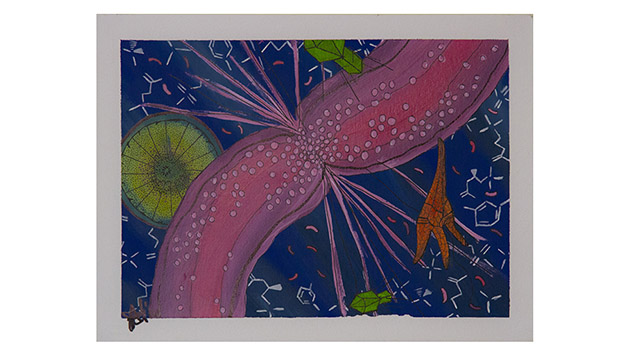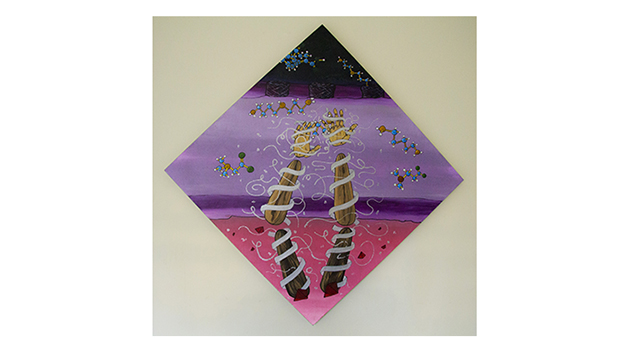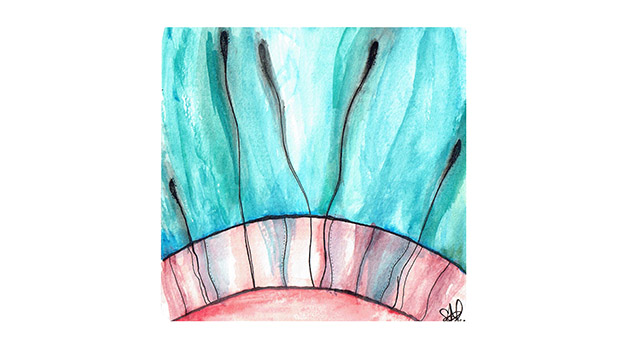An Artist at Sea

Artist Samm Newton created this small acrylic painting in September 2016 while on board the research vessel Atlantic Explorer. This piece was inspired by the various scientists working on the cruise, each studying a different aspect of marine microbiology to create a more complete picture of global biogeochemical cycles.
What keeps you up at night? Barking dogs, traffic in the city, perhaps noisy neighbors? For Samm Newton, a graduate student in the Oregon State University (OSU) Environmental Arts and Humanities program, it’s the challenges of connecting the public with the complex, global environmental threats facing society.
“During my work in the environmental nonprofit sector it seemed that so many people were disconnected from nature and natural processes,” she recalls.
Intrigued by this observation, Newton wondered if this disconnect could help explain why many environmental messages, particularly those about the ocean, fail to resonate with people.

The work of doctoral student Stephen Noell inspired this acrylic painting, completed on a 3-by-3 foot canvas. Noell studies the physiology of the SAR11 bacteria, the most abundant organism in the ocean and one that also plays an important role in the global carbon cycle. He described to Newton how energy is transported in a SAR11 bacterium and she based this piece on her understanding of that process.
With an undergraduate degree in psychology, a minor in anthropology, several years of experience as an environmental communications coordinator, and a passion for art and storytelling, Newton began to think her unique combination of skills and passions could help people forge deeper connections to the natural environment. Her goal is to promote a deeper awareness of the dependency between humans and the planet and, hopefully, encourage people to engage in sustainable behavior in their daily lives.
“Using photography, acrylic painting and watercolor to highlight certain aspects of science is one of the methods of communicating that I’m experimenting with,” she says. “I want to express the beauty and intrinsic value of marine ecosystems in an effort to connect the processes found in the ocean with global issues, such as climate change.”
As part of the tight-knit community of artists in Corvallis, Oregon, Newton heard about a call for local artists to work with the OSU Department of Microbiology to produce art for a show entitled Microbiomes: To See the Unseen. The juried exhibition of visual art, music, and poetry is a collaboration between OSU’s research community and The Corvallis Arts Center. Scheduled for April 13 through May 27, 2017, the show and its catalog of work are designed to offer a unique perspective on microbial systems that impact human health, including those in the air, earth, and water.
In a decision that she credits with catalyzing her new journey, she reached out via email to Stephen Noell, a doctoral candidate in Stephen Giovannoni’s lab at OSU, and explained her idea of encouraging public interest in science by sharing a new perspective of marine scientists and their work.
“I liked her vision of conveying science to other people through artwork and writing,” Noell said. “I appreciated that she was genuinely interested in allowing the public to connect with how science is done and helping them relate to the people behind the science.”

This small watercolor painting was created by Newton during her time on the R/V Atlantic Explorer. It was inspired by a recent paper by Stephen Giovannoni, the scientist credited with the discovery and description of SAR11. This piece is Newton’s interpretation of a SAR11 bacterium cell wall.
In September, Newton arrived in Bermuda to embark on a three-day scientific cruise aboard the research vessel Atlantic Explorer to begin her new project. The cruise, led by Giovannoni as part of the BIOS-SCOPE program, took Newton and a host of researchers on a two-hour trip to the Bermuda Atlantic Time-series Study (BATS) site, located southeast of Bermuda in the western Sargasso Sea. She joined scientists investigating the role that marine microbial communities play in the global carbon cycle. While researchers worked around the clock, Newton explored, observed, and documented their work.
“One of the most inspirational aspects of my experience was seeing the interconnection of the scientists’ work,” she said. “While each group had their own specific area of study, it is their cumulative effort and the blending of different expertise that will expand our knowledge.” In fact, this is the over-arching goal of the BIOS-SCOPE research program: leveraging cross-disciplinary scientific collaborations to better understand the ocean’s microbial processes.
The cruise gave Newton a new perspective on science, and offered participating scientists a new perspective on art. For most of the researchers on board, this was their first time working with an on-board artist who wanted to talk with, observe and take pictures of them.
“It’s not every day that an artist joins a science cruise,” Giovannani said. “As a scientist, you can’t help but think: how does an artist see this?”
Newton returned from the cruise with hundreds of photographs, pages of notes and even a few paintings. In her studio, she is putting the finishing touches on half a dozen pieces that she will submit for inclusion in the Microbiomes show. With these, Newton hopes to capture the enthusiasm and passion of the scientists in her creations.
“I want people to walk away from my paintings with a renewed sense of curiosity about the world,” she says. “The goal is to light a fire.”
